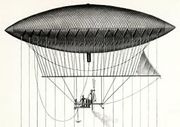Lighter than air The 1884 La France, the first fully controllable airship
The 1884 La France, the first fully controllable airship
Although many people think of human flight as beginning with the aircraft in the early 1900s, in fact people had already been flying for some 200 years.
The first generally recognized human flight took place in Paris in 1783. Jean-François Pilâtre de Rozier and François Laurent d'Arlandes went 5 miles (8 km) in a hot air balloon invented by the Montgolfier brothers. The balloon was powered by a wood fire, and was not steerable: that is, it flew wherever the wind took it.
 The navigable balloon created by Giffard in 1852
The navigable balloon created by Giffard in 1852Ballooning became a major "rage" in Europe in the late 18th century, providing the first detailed understanding of the relationship between altitude and the atmosphere.
Work on developing a steerable (or dirigible) balloon (now called an airship) continued sporadically throughout the 1800s. The first powered, controlled, sustained lighter-than-air flight is generally believed to have taken place in 1852 when Henri Giffard flew 15 miles (24 km) in France, with a steam engine driven craft.
Another notable advance was made in 1884, when the first fully controllable free-flight was made in a French Army electric-powered airship, La France, by Charles Renard and Arthur Krebs. The 170 foot long , 66,000 cubic foot airship covered 8 km (5 miles) in 23 minutes with the aid of an 8-1/2 horsepower electric motor.
However, these aircraft were generally short-lived and extremely frail. Routine, controlled flights would not come to pass until the advent of the internal combustion engine (see below.)
Although airships were used in both World War I and II, and continue on a limited basis to this day, their development has been largely overshadowed by heavier-than-air craft.
ไม่มีความคิดเห็น:
แสดงความคิดเห็น